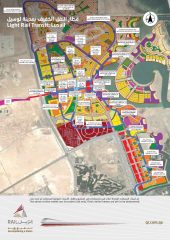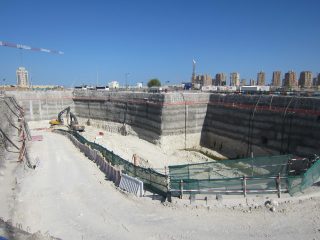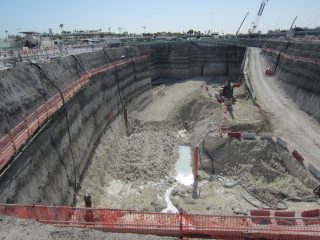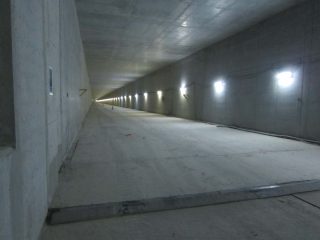
Qatar’s rail office has released fresh details this week of its rollout of the country’s new transportation network, including detailed route maps and a timeline for moving passengers between here and Saudi Arabia on high-speed trains.
With traffic congestion a near-constant frustration for Doha’s growing population, government authorities are counting on its rail projects to get commuters out of their vehicles.
The first passenger won’t board the Doha Metro until 2019, but Qatar Rail is already touting the advantages of rapid transit over traveling by car. According to officials, residents would save commuting time if they took the metro, instead of traveling in cars.
Video: Inside the Lusail Light Rail tunnels
For example, the trip between Msheireb and Education City on the metro would take some 16 minutes – saving commuters at least 12 minutes if the journey was taken by car, according to Qatar Rail.
Similarly, a trip between Qatar University and Msheireb would take 18 minutes by rail, compared to 28 minutes by private vehicle.
Qatar Rail released the travel information during a press conference and site visit on Monday to update the media on its plans and progress in constructing the country’s rapid transit network.
The government has so far awarded approximately $32 billion worth of contracts, although that figure will climb as it signs agreements to construct additional metro lines, the high-speed rail network as well as purchase locomotives and passenger vehicles.
During Monday’s meeting with journalists, Qatar’s national rail network further explained their three projects, which include:
1) Doha Metro, which will enter operations in 2019 with 37 stations. The lines, which include underground, surface level and elevated portions, are slated to be extended to 56 stations by 2026.
2) The Lusail light-rail transit project, consisting of 37 stations along a 30.5km track. While most of it will be constructed at ground level, the four Lusail LRT lines also include 10km of tunnels – which have all been completed – and a 1km elevated section. While this is a separate project from the Doha Metro, passengers would be able to transfer between the two lines at the Lusail Marina / Pearl station.
The LRT is scheduled to enter service in 2017, officials said this week, although QRail’s health and safety director told Doha News last month that trains would start running between three stations as part of the project’s first phase in 2016.

3) A long-distance passenger and freight rail network expected to be at least 350km long, isn’t scheduled to be completed until 2029. Passenger trains, which would be boarded at the Education City station, will travel at speeds between 220 and 350 kmh, while freight vehicles will reach speeds approaching 120 kmh.
Hamad Ibrahim Al Bishri, QRail’s chief program officer and deputy CEO, told reporters that the government is in the process of awarding a design contract for the first phase of the network, which would connect Qatar with Saudi Arabia. Construction would begin in the third quarter of 2015 and wrap up by 2017-18, although many months of testing and final fit-ups would likely precede the first passenger trip.
In addition to the passenger and freight line between Doha and Saudi Arabia, the long-distance network includes lines connecting:
- Port Mesaieed and Ras Laffan (freight);
- Doha and Bahrain (passengers);
- Doha and Dukhan (passengers and freight);
- Doha to Al Shamal (passengers and freight).
Monday’s press conference also yielded several other new pieces of information about the rapid transit projects:
Metro routes
Maps given to journalists provide more details about the routes that the four colored lines will follow.
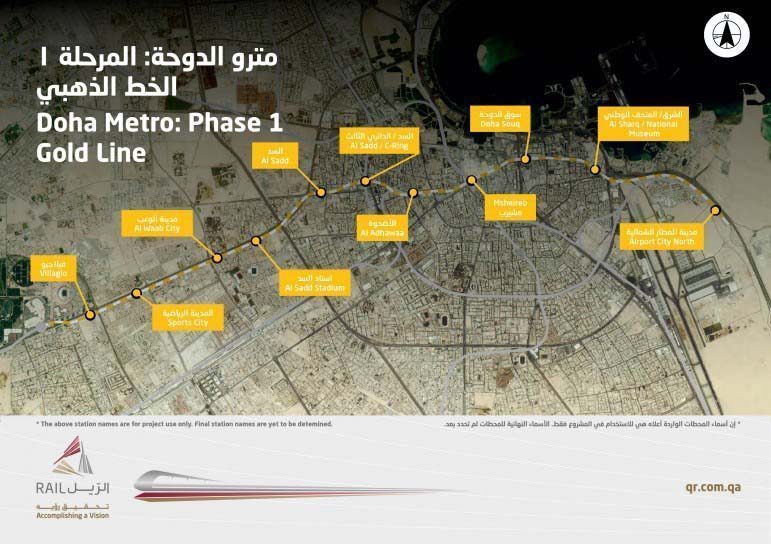
The east-west Gold Line will start at Villaggio mall and run beneath Al Waab Street. It follows the road’s northward bend at the Doha Expressway before turning east again at Al Sadd Street. It curves to cross C-Ring slightly north of Al Sadd Street before veering southeast, cutting through residential areas of Fereej bin Mahmoud and then following Qatari bin Al Fujaah Street and Al Adhwaa Street into Msheireb station.
From there, it runs below Wadi Msheireb Street / Ali bin Abdullah Street before curving south to follow Ras Abu Abboud Street past the northern end of Doha International Airport’s runway.
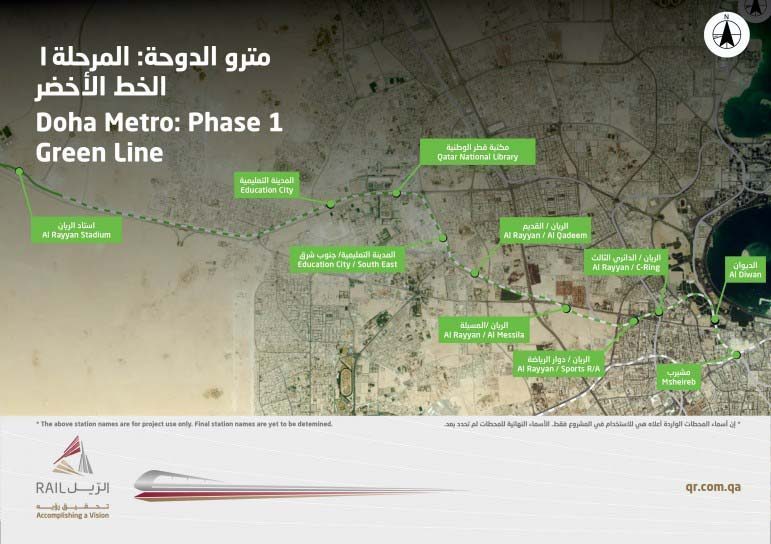
The east-west Green Line starts at Al Rayyan Stadium and briefly runs at ground level before descending into a tunnel below the Dukhan Highway, which turns into Al Luqta Street as it passes Education City.
After stopping at the under-construction Qatar National Library, the Green Line turns south at Huwar Street. It turns east at Al Rayyan Al Jadeed Street, crosses under the Doha Expressway and then runs alongside Al Rayyan Road. It arches north as it crosses the Hamad Medical Center before turning almost due south into Msheireb.
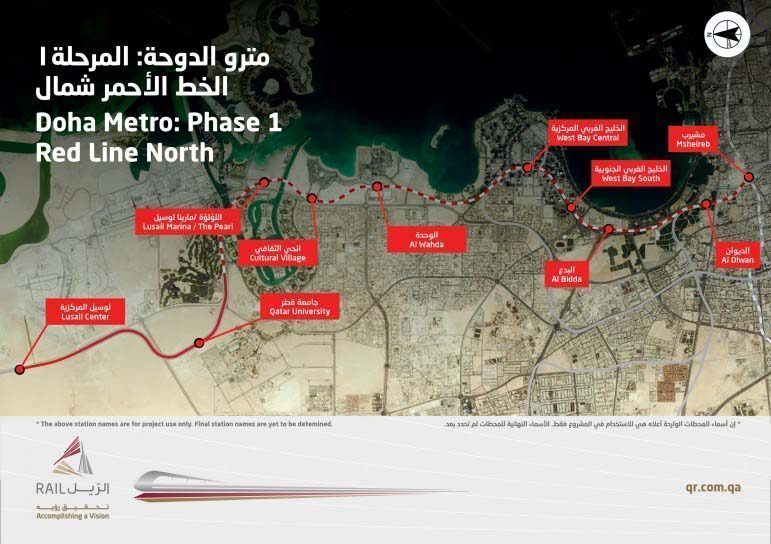
The maps for the northern section of the Red Line appear to actually start with a section of the Lusail LRT. The route starts at the surface running along the Al Khor Coast Road before veering into the campus of Qatar University and then heading east along the southern boundary of the Doha Golf Club. Entering an underground tunnel, it passes the Grand Hyatt hotel before stopping in Katara Cultural Village.
It then runs between the Qatar International Exhibition Center and the InterContinental Doha into the Dafna central business district, where it appears to follow Omar Al Mukhat Street past City Center Mall and the under-construction Doha Convention Center. Running parallel to the Corniche, the Red Line runs along Majlis Al Taawon towards Msheireb.

Heading south, the Red Line leaves Msheireb and snakes its way onto Al Matar Street until it clears the runways of the old airport, at which point it turns east into the new Hamad International Airport.
Big dig
According to authorities, Qatar plans to utilize some 21 tunnel boring machines to cut circular holes in the ground beneath Doha. The machines are scheduled to start drilling next year, with all 21 expected to be operational by 2015.

Officials say residents may feel “minor vibrations” during work.
The Green and Red lines run at an average of 20 to 25 meters below the surface.
Projections
It’s tough to come up with hard ridership forecasts when Qatar’s population is growing much faster than expected, said Markus Demmler, the project director for the Doha Metro.
However, he told Doha News that he expects 20 to 25 percent of all trips to be taken by rapid transit each day when it first enters service. The number is expected to rise in subsequent years.
In a handout, QRail said it expects “17,000 cars to be off the street” once the full Metro system has been in operation for several years in 2030.
Working conditions
QRail “knows what has been said” about Qatar’s human rights record and is imposing “rigorous” rules on its contractors regarding to the living and working conditions of laborers, Al Bishri told reporters, according to a translation.
This includes giving each worker their own personal space in their living accommodations as well as providing meals, transportation, laundry and cleaning services.
Laborers work 10-hour days with a one-hour break, six days a week, he said. Employees receive overtime pay for the sixth day, Al Bishri added.
Before starting work, new laborers must receive four hours of safety training in their native language and pass a test.
“We want the laborer to know the quality of his work and his contribution to the project is significant,” Al Bishri said.
Thoughts?


